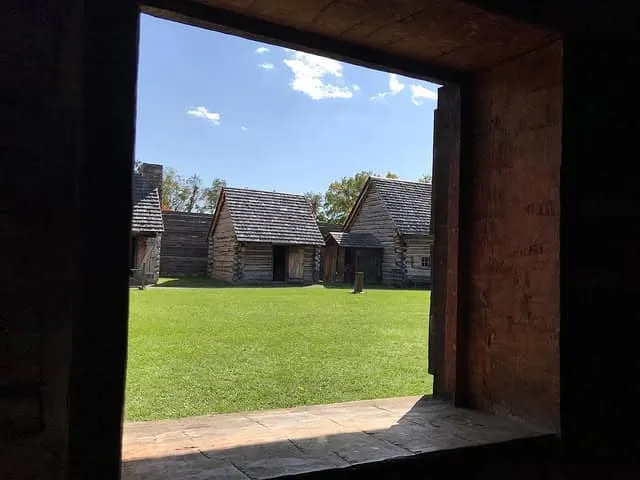
Fort Roberdeau Historic Site and Natural Area includes an 1858 barn containing exhibits and a museum shop, an education center in an 1860 farmhouse, three nature trails, picnic facilities, and White Oak Hall, a large multipurpose facility. The original Fort Roberdeau was constructed in 1778 under the direction of General Daniel Roberdeau, one of Pennsylvania's representatives to the Second Continental Congress. Also known as the "Lead Mine Fort," it protected lead mining and smelting operations which provided ammunition to the Continental Army. It supported settlers who remained on the frontier as militia and rangers, providing vital defense against actual raids and potential large attacks launched from British Forts Niagara and Detroit. Supplies of ordnance and ammunition for the area then designated as Bedford County were stored at the fort.
The History of Fort Roberdeau
The "Lead Mine Fort," as it was called in the 18th century, was built during the spring and summer of 1778 to protect lead mining operations in Sinking Stream Valley. Those who most likely aided in its construction were militia from Cumberland and Bedford Counties, members of Bedford Co. Ranging Companies and local settlers. General Daniel Roberdeau, who directed the work, was a wealthy merchant, a member of Congress and a Brigadier General elected by the Associators of Philadelphia. He arrived in late April with intentions of establishing a lead smelting operation and constructing a stockade. Unlike most frontier forts built of logs placed vertically, this one was necessarily constructed of horizontal logs. The limestone strata of the valley, with scant topsoil, prevented the normal procedure of digging a trench, standing the logs in it, and then backfilling. The fort was never attacked, but served as a safe refuge to soldiers, lead miners and local settlers. It was designated as a storage depot for ordnance and ammunition for the Bedford County area until March, 1780, and contained four double fortified four pounder cannons with travelling carriages. Lead produced here was most likely taken to Water Street landing and sent by the Juniata and Susquehanna Rivers to soldiers in the East.
Location of the FortConstruction of the original Fort Roberdeau began in April 1778 within Sinking Spring Valley Manor, an area now known as Tyrone Township, Blair County. The term "manor" was applied to the most valuable areas of the Penn family's tracts of land. This manor contains lead, zinc, nickel, iron, good water supplies, and fertile soil. During the American Revolution, 1775-1781, the area surrounding the three tributaries of the Juniata River (the Little Juniata, the Frankstown Branch, and the Raystown Branch) was part of Bedford County. Fort Roberdeau was located in Bedford County. The bordering counties were Cumberland on the east and Westmoreland on the west.
Daniel Roberdeau Brigadier
General Daniel Roberdeau was the first person elected to the rank of General on July 4, 1776, by the Associators of Pennsylvania. The Associators were groups of patriots organized in a system devised by Benjamin Franklin in 1747. The Associators were the forerunners of today's National Guard units. Roberdeau was a prosperous Philadelphia merchant who fervently advocated independence. As an elected representative from Pennsylvania to the Second Continental Congress, he served as a member of the intelligence committee and the committee that procured supplies for the Continental Army. He was fully aware of the shortages of supplies for the Army. He strongly advocated the production of lead in the colonies, since it was difficult to import lead during the Revolution. When Congress received word of the presence of lead ore in Sinking Spring Valley, Pennsylvania, Roberdeau personally undertook the responsibility of verifying the report and starting a mining operation. His journey began at York, PA, where the Congress had fled following the 1777 defeats at Brandywine and Germantown and the occupation of Philadelphia by the British under General Howe. (Washington and his troops spent the winter of 1777-78 at Valley Forge.) Correspondence from Roberdeau documents his trip. He went to the military depot at Carlisle, PA, to request soldiers and supplies, and then started for Sinking Spring Valley, probably via the Juniata River. After a brief stay in Huntington, he arrived in the Valley in late April. Many local people were heading east at that time due to rumors of imminent raids by a large force of British Rangers, Iroquois and loyalist sympathizers. Roberdeau soon decided to "erect a stockade to protect the reducing works", and tried to persuade people to stay in the area to defend the frontier.Officers' Quarters
The officers' quarters were used as both a living quarters and the administrative office of the fort. Some of the officers were Major Robert Cluggage, Capt. Thomas Cluggage, Capt. John Lane, Capt. John MacDonald, Capt. Henery Black, and Lt. Robert Gaibraith. Under the Militia Law of March 1777, the men elected all officers in each frontier county's battalion. Colonels, Lt. Colonels, and Majors were required to be resident freeholders within the battalion's district, while company grade officers were selected from the voters. Officers used various methods to enlist volunteers in their companies. Usually, enlistees were offered a bounty for enlisting in addition to their regular monthly pay. In 1779, the bounty was a suit of clothes. 1n 1778, Thomas Cluggage's company received a bounty of sixty dollars. Volunteers were also recruited by promises of land grants after the war. A drawing of the 1778 fort and three nearby buildings appeared in a 1788 (10 years later) issue of The Columbian, a magazine published by the Penns. During the 19th century, few records mention the fort. Parts of it may have been recycled into other buildings. Moisture and insects would have caused deterioration of the wood rather quickly.


